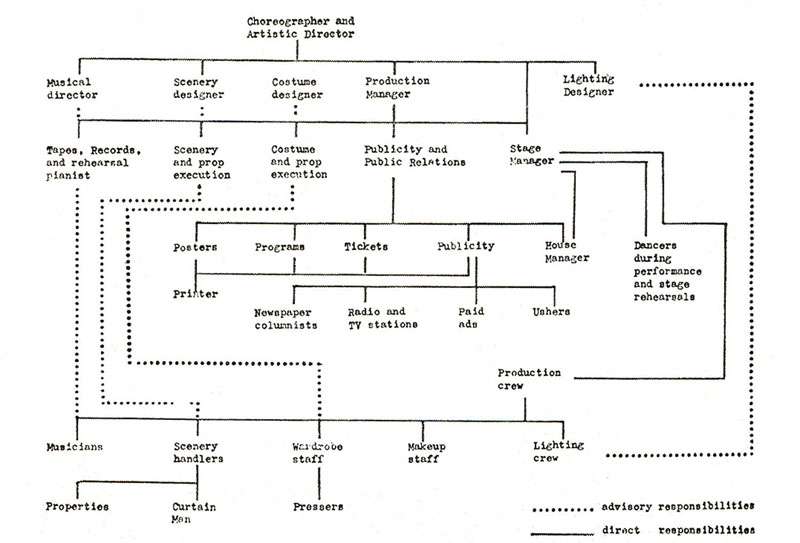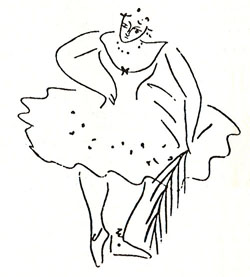
BY TOM SKELTON
courtesy of
Dance Magazine
first published
May 1957
PREPARING THE RECITAL: The Production Staff
The Production Staff should have its first meeting at least two months before the recital. Presumably you have selected its members with careful considerations of their experience and potentials, and discussed their respective jobs with them so they will know what will be required. Even this first meeting must be conducted as a business meeting rather than a social affair. Everyone should be seated at a table with pencil and paper. If you feel refreshments are in order, they should come after, not during the meeting. Start promptly and set a precedent. You may have to have staff meetings every week, so it’s best at the first meeting to establish basic procedure for future meetings, when economy if time and energy will be of utmost importance.

The Production Staff should consist of:
The Production Manager
The Production Manager. He is your most important staff member because his job is to serve as your assistant, your alter-ego in charge of everything except the strictly artistic decisions that rest in your hands. He should draw up the rehearsal schedule and the production schedule. At the meetings he will hear the reports from all the staff members, as well as your report on the choreography, and keep after everyone to meet deadlines.
Publicity and Public Relations
The Publicity and Public Relations staff member’s first job would be to find out where and how much of printing, mimeographing of programs and cost of ads in the local papers. After consultation with the Production Staff he may decide to announce the recital several ways simultaneously: mailing several thousand post-cards (each student should have a handful to mail to friends); giving a cocktail party for the press and local dignitaries (this would pull in the society editors too); and the first ad in the newspaper. Local radio and TV stations might be interested in interviewing you and/or some of your staff members. Local columnists will certainly give the recital a line or two. Among students and their families may be contacts who have store windows that could be used for a display, printers and commercial artists who would contribute their time if the materials were supplied, and sources of materials for the production (be sure they receive program credit). The Publicity and Public Relation Representative’s job is limited only by his imagination.
Among his duties, which he may delegate to an assistant, is the layout and printing of the programs. Whether it is to be elaborately printed or inexpensively mimeographed, the program will be something for people to save in their scrapbooks or post on their bulletin boards, if it is designed with taste and flair. Many elaborate programs pay for themselves if local merchants take ad, but the ads must be inexpensive since they will be given more out of courtesy than out of any conviction that they will serve as valuable publicity. From the Production Manager he will get the program order, program notes, and the names of the performers. From all production staff members he will get the names of their assistants as well as the names of merchants and craftsmen who should be thanked for their help.
The Reservations Chairman
The Reservations Chairman should work very closely with the Publicity and Public Relations staff. If you plan to sell tickets for the recital you’ll need legal advice on tax problems, but even if admission is free I would still recommend that you have tickets. Demand increases when tickets are required, and there is the further advantage of knowing how large an audience to expect. Maybe you’ll have to give an added performance. Decide whether you want to reserve the seats individually or by sections. Be sure to send a pair of complimentary tickets to critics and to anyone who has contributed services or materials to the production. You may also want to give each performer and all members of the Production Staff and their assistants a complimentary pair. Whether you are selling or giving tickets, al announcements should tell where tickets may be procured. Request that a stamped, self-addressed envelope be enclosed with each order lest you find your budget swelling unexpectedly. The Reservation Chairman should have the ticket situation in hand.
The House Manager
If your theatre does not include a staff in the rental price, a House Manager must be added to your staff. His job is to recruit the ushers, borrow flashlights for them, decide how they shall dress, train them on seat locations and methods of seating the audience, be sure proper temperature is maintained in the auditorium, see that the audience is called back at the end of intermission, be sure the lobby doors are closed at the beginning of the program and distracting lights turned out, and that the doors are opened for intermission and at the end of the program. He should pre-arrange a signal with the Stage Manager so that he will know when the dancers are ready and the audience should be called in.
Costume, Lighting, & Scenery Designers
The staff members concerned with the more creative aspects of designing scenery, costumes, and lighting must work closely with you since their jobs are merely to elaborate your choreographic plans. If experienced designers will help you, and well they might since dance design provides a challenge they may find irresistible, so much the better. They must be made to understand at the offset, however, what their budget limitations will be. In many cases the designer and a staff of assistants recruited from the mothers and fathers will execute the designs. There can be several Costume Designers and several people to execute the costumes if it seems wiser to spread the work, but the Lighting Designer and Scenery Designer should best be restricted to one person each, since their designs must carry through the entire program with an over-all plan.
The Production Manager must check these departments often to be sure that the designers are living up to the production schedule, and that the costumes and scenery are being made on schedule. Costume fittings must be co-ordinated with the rehearsal schedule. By the last week of rehearsal the costumes should be finished so that the dancers can wear them and find out what new problems they present. The scenery, too, and especially the props handled by the dancers, must be introduced into rehearsals as soon as possible.
The Musical Director
The Musical Director should help you plan every phase of the music. If the piano is to be used for the performance, rehearsal records or tapes should be made so that the pianist need not attend every rehearsal. But throughout the rehearsal period the pianist should play for “run-throughs” every now and then to be sure the tempos are maintained, as well as to keep the pianist himself rehearsed in strict tempos. If tapes or recordings are to be used for the performance, the Musical Director can advise you on what music to be used and where cuts and tempo changes can be made that will not offend the delicate ears of any musicians who may be in the audience. If recorded music is to be used, the auditorium equipment must be checked for speed, to be sure it is the same as the rehearsal equipment. Both the March and the May 1956 issues of DANCE magazine have articles that will help your Musical Director find appropriate music and decide whether it should be used “live” or “canned.”
The Stage Manager
When it comes to the actual performance, the Stage Manager is the most important member of the Production Staff. The Production Manager’s job is to have everything ready for the first technical rehearsal. The Stage Manager then takes over and runs all rehearsals in the theatre and the actual performances. He should be the most “professional” member of your staff; in fact, if the budget permits, you should hire a professional. The Stage Manager gives all cues for curtain, lights, scenery changes, and for the music to begin. He is responsible for having the dancers ready in costume and makeup before each number starts. Most important, he is the man who must be able to make an instantaneous decision when something goes wrong, whether it be a costume that falls apart, a blown fuse, or an accident on stage. On him rests the entire responsibility of the performance, so choose him carefully and you will be able to watch the show from the audience.
The Makeup Supervisor
Makeup should be no problem, but somehow it often is unless it has been planned in advance. Doting mothers tend to plaster lipstick and rouge all over their children and get themselves and their children into a nervous state backstage. It would seem wiser to have a “makeup session” directed by your Makeup Supervisor, about a week before the performance. This could be done at the studio after a rehearsal. Its purpose is to teach the dancers to put on their own makeup if they are old enough, for putting on grease-paint is part of the thrill of being a dancer. Before the performance the Makeup Supervisor need only check each dancer briefly to be sure the makeup has been applied as rehearsed.
In general, very little makeup is necessary for a recital. The girls should cold-cream their faces and wipe it off carefully. Then they pat on powder of the proper shade, and the slight film of cold-cream will hold it in place. A dark eyebrow pencil to outline the eyes and darken the eyebrows, a little lipstick and possibly a little rouge will complete the makeup. If they want to use a little blue or green eyeshadow it should be applied before the powder, so that the powder will “set” it. The boys should cold-cream their faces, too, and use a darker shade of powder. Don’t forget the necks and ears. Use an eyebrow pencil to outline the eyes, darken the eyebrows, and lightly outline the lips. No lipstick or rouge is necessary for the boys. If the lighting for any of the dances is a rich color like red or green, the makeup should be tested under the lights. The chart published in the July 1956 issue of this series will help you make any necessary adjustments.
(more next month)
